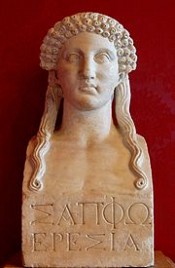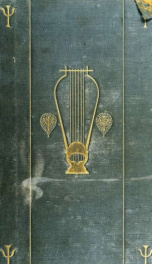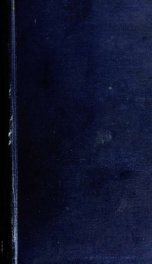sappho

Sappho (pronounced /ˈsæfoʊ/ in English; Attic Greek Σαπφώ IPA: [sapːʰɔː], Aeolic Greek Ψάπφω [psapːʰɔː]) was an Ancient Greek poet, born on the island of Lesbos. Later Greeks included her in the canonical list of nine lyric poets. Her birth was sometime between 630 and 612 BC, and it is said that she died around 570 BC, but little is known for certain about her life. The bulk of her poetry, which was well-known and greatly admired throughout antiquity, has been lost, but her immense reputation has endured through surviving fragments. The adjectives deriving from her name and place of birth (Sapphic and Lesbian) came to be associated with female homosexuality. The only contemporary source which refers to Sappho's life is her own body of poetry, and scholars are skeptical of biographical readings of it. Later biographical traditions, from which all more detailed accounts derive, have also been cast into doubt.[1] Strabo says that Sappho was the contemporary of Alcaeus of Mytilene (born ca. 620 BC) and Pittacus (ca. 645 - 570 BC) and according to Athenaeus she was the contemporary of Alyattes of Lydia (ca. 610 - 560 BC). The Suda, a 10th century Byzantine encyclopædia, dates her to the 42nd Olympiad (612/608 BC), meaning either that she was born then or that this was her floruit. The versions of Eusebius state that she was famous by the first or second year of the 45th or 46th Olympiad (between 600 and 594 BC). Taken together, these references make it likely that she was born ca. 620 BC, or a little earlier. Judging from the Parian Marble she was exiled from Lesbos to Sicily sometime between 604 and 594 BC. If fragment 98 of her poetry is accepted as biographical evidence and as a reference to her daughter (see below), it may indicate that she had already had a daughter by the time she was exiled. If fragment 58 is accepted as autobiographical it indicates that she lived into old age. If her connection to Rhodopis (see below) is accepted as historical it indicates that she lived into the mid-6th century BC.[2][3] An Oxyrhynchus papyrus from around AD 200[4] and the Suda agree that Sappho had a mother called Cleïs and a daughter by the same name. Two preserved fragments of Sappho's poetry refer to a Cleïs. In fragment 98, Sappho addresses Cleïs, saying that she has no way of obtaining a decorated headband for her. Fragment 132 reads in full: "I have a beautiful child [pais] who looks like golden flowers, my darling Cleis, for whom I would not (take) all Lydia or lovely..."[5] These fragments have often been interpreted as referring to Sappho's daughter or as confirming that Sappho had a daughter with this name. But even if a biographic reading of the verses is accepted, this is not certain. Cleïs is referred to in fragment 132 with the Greek word pais, which can as easily indicate a slave or any young person as an offspring. It is possible that these verses or others like them were misunderstood by ancient writers, leading to the biographical tradition which has come down to us.[6] Fragment 102 has its speaker address a "sweet mother", sometimes taken as an indication that Sappho began to write poetry while her mother was still alive.[7] The name of Sappho's father is widely given as Scamandronymus,[8] he is not referred to in any of the surviving fragments. In his Heroides, Ovid has Sappho lament that, "Six birthdays of mine had passed when the bones of my parent, gathered from the pyre, drank before their time my tears." Ovid may have based this on a poem by Sappho no longer extant.[9] Sappho was reported to have three brothers; Erigyius (or Eurygius), Larichus and Charaxus. The Oxyrhynchus papyrus says that Charaxus was the eldest but that Sappho was more fond of the young Larichus.[10] According to Athenaeus, Sappho often praised Larichus for pouring wine in the town hall of Mytilene, an office held by boys of the best families.[11] This indication that Sappho was born into an aristocratic family is consistent with the sometimes rarefied environments which her verses record. A story given by Herodotus and later by Strabo, Athenaeus, Ovid and the Suda, tells of a relation between Charaxus and the Egyptian courtesan Rhodopis. Herodotus, the oldest source of the story, reports that Charaxus ransomed Rhodopis for a large sum and that after he returned to Mitylene, Sappho scolded him in verse.[12] Strabo, writing some 400 years later, adds that Charaxus was trading with Lesbian wine and that Sappho called Rhodopis Doricha. Athenaeus, another 200 years later, calls the courtesan Doricha and maintains that Herodotus had her confused with Rhodopis, another woman altogether.[13] He also cites an epigram by Posidippus (3rd c. BC) which refers to Doricha and Sappho. Based on this story, scholars have speculated that references to a Doricha may have been found in Sappho's poems. None of the extant fragments have this name in full but fragments 7 and 15 are often restored to include it.[14] Joel Lidov has criticized this restoration, arguing that the Doricha story is not helpful in restoring any fragment by Sappho and that its origins lie in the work of Cratinus or another of Herodotus' comic contemporaries.[15] The Suda is alone in claiming that Sappho was married to a "very wealthy man called Cercylas, who traded from Andros"[16] and that he was Cleïs' father. This tradition may have been invented by the comic poets as a witticism, as the name of the purported husband means "prick from the Isle of Man."[17] Sappho's lifetime was a period of political turbulence on Lesbos and saw the rise of Pittacus. According to the Parian Marble, Sappho was exiled to Sicily sometime between 604 and 594 and Cicero records that a statue of her stood in the town-hall of Syracuse. Unlike the works of her fellow poet, Alcaeus, Sappho's surviving poetry has very few allusions to political conditions. The principal exception is fragment 98 which mentions exile and indicates that Sappho was lacking some of her customary luxuries. Her political sympathies may have lain with the party of Alcaeus.[18] Though there is no explicit record of this it is usually assumed that Sappho returned from exile at some point and that she spent most of her life in Lesbos. A tradition going back at least to Menander (fr. 258 K) suggested that Sappho killed herself by jumping off the Leucadian cliffs for love of Phaon, a ferryman. This is regarded as unhistorical by modern scholars, perhaps invented by the comic poets or originating from a misreading of a first-person reference in a non-biographical poem.[19] The legend may have resulted in part from a desire to assert Sappho as heterosexual.[20] Sappho's poetry centers on passion and love for various personages and both genders. The word lesbian derives from the name of the island of her birth, Lesbos, while her name is also the origin of the word sapphic; both words were only applied to female homosexuality beginning in the 19th century.[21][22] The narrators of many of her poems speak of infatuations and love (sometimes requited, sometimes not) for various females, but descriptions of physical acts between women are few and subject to debate.[23][24] Whether these poems are meant to be autobiographical is not known, although elements of other parts of Sappho's life do make appearances in her work, and it would be compatible with her style to have these intimate encounters expressed poetically, as well. Her homoerotica should be placed in the seventh century (BC) context. The poems of Alcaeus and later Pindar record similar romantic bonds between the members of a given circle.[25] Sappho's contemporary Alcaeus described her thus: "Violet-haired, pure, honey-smiling Sappho" (ἰόπλοκ᾽ ἄγνα μελλιχόμειδε Σάπφοι, fr. 384). The 3rd century philosopher Maximus of Tyre wrote that Sappho was "small and dark" and that her relationships to her female friends were similar to those of Socrates: During the Victorian era, it became the fashion to describe Sappho as the headmistress of a girls' finishing school. As Page DuBois (among many other experts) points out, this attempt at making Sappho understandable and palatable to the genteel classes of Great Britain was based more on conservative sensibilities than evidence. There are no references to teaching, students, academies, or tutors in any of Sappho's scant collection of surviving works. Burnett follows others, like C.M. Bowra, in suggesting that Sappho's circle was somewhat akin to the Spartan agelai or the religious sacred band, the thiasos, but Burnett nuances her argument by noting that Sappho's circle was distinct from these contemporary examples because "membership in the circle seems to have been voluntary, irregular and to some degree international."[26] The notion that Sappho was in charge of some sort of academy persists nonetheless. The Library of Alexandria collected Sappho's poetry into nine books, mostly based on their meter: Not every surviving fragment can be assigned to a book (frr. 118–213 are unassigned), and other meters are represented in the fragments. The surviving proportion of the nine-volume corpus of poetry read in antiquity is small but still constitutes a poetic corpus of major importance. There is a single complete poem, Fragment 1, the Hymn to Aphrodite,[27] quoted in its entirety as a model of the "polished and exuberant" style of composition by Dionysius of Halicarnassus, with admiration of its consummate artistry:[28] Other major fragments include three virtually-complete poems (in the standard numeration, fragments 16, 31, and the recently supplemented 58). The most recent addition to the corpus is a virtually-complete poem on old age (fr. 58). The line-ends were first published in 1922 from an Oxyrhynchus papyrus, no. 1787 (fragment 1: see the third pair of images on this page), but little could be made of them, since the indications of poem-end (placed at the beginnings of the lines) were lost, and scholars could only guess where one poem ended and another began. Most of the rest of the poem has recently (2004) been published from a 3rd century BC papyrus in the Cologne University collection. The latest reconstruction, by M. L. West, appeared in the Zeitschrift für Papyrologie und Epigraphik 151 (2005), 1-9, and in the Times Literary Supplement on 21 June 2005 (English translation and discussion). The poem refers to the plight of Tithonus, with whom the goddess Eos fell in love and requested he become immortal, but forgot to ensure that he stay forever young. The Greek text has been reproduced with helpful notes for students of the language.[29]
do you like this author?
What readers are saying
What do you think? Write your own comment on this book!
write a commentWhat readers are saying
What do you think? Write your own comment on this author!
write a commentBook list

La chaste Sappho de Lesbos et Stesichore, dont la concurrence et les prétentions lui inspirèrent l'Ode 2. Les trois dernières strophes, manquant à ce poème, sont reconstituées ici, pour la première fois, au moyen de deux fragments dont voici le plus mutil
Series:
Unknown
Year:
Unknown
Raiting:
4.5/5
26
Show more
add to favoritesadd In favorites
Book list

La chaste Sappho de Lesbos et Stesichore, dont la concurrence et les prétentions lui inspirèrent l'Ode 2. Les trois dernières strophes, manquant à ce poème, sont reconstituées ici, pour la première fois, au moyen de deux fragments dont voici le plus mutil
Series:
Unknown
Year:
Unknown
Raiting:
4.5/5
26
Show more
add to favoritesadd In favorites

Sappho. Memoir, text, selected renderings and a literal translation
Series:
Unknown
Year:
Unknown
Raiting:
2.5/5
Book digitized by Google and uploaded to the Internet Archive by user tpb.
Show more
add to favoritesadd In favorites

Vita e frammenti di Saffo da Mitilene
Series:
Unknown
Year:
Unknown
Raiting:
2.5/5
Book digitized by Google from the library of the University of Michigan and uploaded to the Internet Archive by user tpb.
Show more
add to favoritesadd In favorites

The poems of Sappho; an interpretative rendition into English
Series:
Unknown
Year:
Unknown
Raiting:
3.5/5
"Of this edition, five hundred copies were printed on hand-made paper from type afterwards distributed, in July, 1910. No.53."
Show more
add to favoritesadd In favorites

Sappho : memoir, text, selected renderings, and a literal translation
Series:
Unknown
Year:
Unknown
Raiting:
2.5/5
Bibliography: p. 199-217
Show more
add to favoritesadd In favorites

sappho memoir text selected renderings and a literal translation
Series:
Unknown
Year:
Unknown
Raiting:
5/5
Show more
add to favoritesadd In favorites
What readers are saying
What do you think? Write your own comment on this author!
write a commentif you like sappho try:
readers also enjoyed
What readers are saying
What do you think? Write your own comment on this author!
write a commentGenre
if you like sappho try:
readers also enjoyed
Do you want to read a book that interests you? It’s EASY!
Create an account and send a request for reading to other users on the Webpage of the book!


